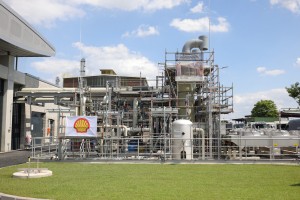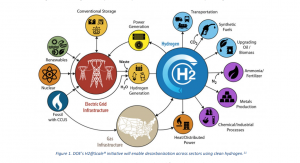From an Article by Ivy Main, Virginia Mercury, April 25, 2023
The hydrogen gold rush is on. Spurred by the urgency of the climate crisis, and attracted by generous incentives in last year’s Inflation Reduction Act, companies ranging from oil majors to small start-ups are pouring money into the Next Big Thing in energy: a fuel that is flexible, transportable and carbon-free.
Is hydrogen a critical piece of the decarbonization puzzle that needs floods of new funding, or an over-hyped, not-ready-for-prime-time financial boondoggle? At this point the answer seems to be both.
In his 2022 Energy Plan, Virginia Gov. Glenn Youngkin touted hydrogen as “a once-in-a-lifetime opportunity to reimagine Virginia’s future and meet energy needs through an abundant, dispatchable, and zero-emission fuel source where water is the only required input.”
This statement has its problems, including the fact that water is actually not the only required input. Making hydrogen from water requires a lot of energy, which must come from some other fuel. Therein lies the rub.
DIAGRAM ~ How the Department of Energy believes clean hydrogen could help decarbonize the U.S. economy. (U.S. Department of Energy)One way to make hydrogen — and the method everyone is talking about — is using electricity to split water (H2O) into its components, hydrogen and oxygen, through electrolysis. Energy is lost in the process, so there is no point in using hydrogen for anything that can plug into the grid. Hydrogen is also more expensive and less efficient than battery storage, which explains why automakers are focusing on electric vehicles rather than ones that run on hydrogen fuel cells.
Yet some kinds of transportation (aviation, long-haul trucking) and many industrial processes are hard or impossible to electrify, at least for now. Hydrogen, ammonia and other products can often replace fossil fuels for these uses, and perhaps also play a role in long-term energy storage for grid power.
Recognizing this potential, last year’s Inflation Reduction Act included a range of incentives to spur investment in so-called green hydrogen, defined as hydrogen made from renewable energy. Growing the supply of green hydrogen will require a massive buildout of wind and solar as well as years of technological refinement, but airlines, steelmakers and other customers are already either starting to use green hydrogen or say they want it for their operations.
Unfortunately, any time the government dangles a subsidy, some businesses will look to exploit any opening to grab free money, even if the result is contrary to the whole point of the subsidy. Those businesses do find champions among politicians who are more interested in generating economic activity than in making sound public policy (or maybe they just confuse the two). But getting the rules right is critical for the climate, and for making sure customers get the carbon-free product they sign up for.
Hydrogen is already used in many industrial processes and in the manufacture of fertilizers but today it is mostly made from methane gas, at half the cost of green hydrogen. Oil companies like Chevron have urged that to build the market quickly, making hydrogen green is “secondary” to making it affordable. This is all wrong. The great promise of hydrogen is the potential to make it from renewable energy once wind and solar have scaled up so much that there is a glut of cheap, emissions-free power.
That is not the situation today. Nationally, fossil fuels make up 60% of electricity generation, with all renewables together representing 21.5%. The regional grid that serves Virginia includes less than 10% wind and solar in the generation mix. Renewables are growing fast while coal shrinks, but few states have so much renewable energy that some of it occasionally goes to waste. California has experienced this under ideal conditions, and is likely to be the first to have surplus renewable energy on a predictable basis.
The challenge is that a company that invests in the capital costs of a hydrogen production facility may not want to run it only when there is surplus wind and solar. These companies will make the most money by running their systems around the clock; profitability might even depend on it. Their choices are to build new renewable energy and battery storage for their own purposes and cut back production when they have to, or manipulate the rules.
So as the U.S. Treasury Department writes the rules around eligibility for green hydrogen incentives, corporate America is asking for loopholes. NextEra, the world’s largest renewable power generator, wants to be allowed to use fossil fuels to fill in whenever there isn’t enough wind or solar energy on the grid, without losing the “green” designation and all the subsidies that accompany it. The company proposes buying carbon credits as an offset.
The proposal makes climate advocates very uneasy. We have seen this movie before. When the federal government first offered subsidies for ethanol made from corn in the 1970s, the idea was that blending American-made ethanol into gasoline would reduce our dependence on foreign oil and lower greenhouse gas emissions.
Forty years later, the program still consumes some 30 million acres of corn every year, and is estimated to have cost taxpayers billions of dollars, all while actually harming the climate. But just try scaling back ethanol subsidies today. Any politician who proposes such a thing gets their head handed to them by the powerful farm lobby.
That makes it really important that rules set into place today for hydrogen and other “green” fuels do not compromise on the requirement that they be made from carbon-free sources. Make an exception once, and we’ll never close the loophole.
###


